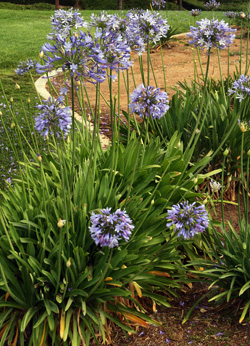Seasonal Agapanthus Care: Getting Ready For Winter Season and Summertime
Seasonal Agapanthus Care: Getting Ready For Winter Season and Summertime
Blog Article
Releasing the Secret to Successful Agapanthus Farming: Idea for a Flourishing Yard
In the world of gardening, cultivating agapanthus efficiently needs a calculated strategy that encompasses numerous aspects of plant care. By comprehending the subtleties of agapanthus farming, one can create an environment where these plants grow and flower abundantly.
Growing Agapanthus: Best Practices
When planting Agapanthus, correct dirt preparation is important for ensuring effective growth and growth of these stunning flowers. Agapanthus, typically called Lily of the Nile or African lily, prospers in well-draining soil with a slightly acidic to neutral pH level - Agapanthus. Prior to growing, it is vital to amend hefty clay soils with raw material such as garden compost or peat moss to improve drain and provide necessary nutrients for the plants
To plant Agapanthus, choose a location that obtains full sunlight to partial shade, as this will certainly promote healthy and balanced development and bountiful blooming. Dig an opening twice the size of the plant's origin round and place the Agapanthus at the exact same deepness it was formerly growing. Delicately backfill the hole with dirt, pushing down securely to eliminate any kind of air pockets around the origins.
Water the recently grown Agapanthus thoroughly and proceed to maintain the soil evenly damp, especially throughout the plant's energetic growing season. Agapanthus. Applying a well balanced plant food once a month can even more sustain the plant's growth and flowering. By complying with these finest methods for growing Agapanthus, you can develop a sensational display of these exciting blossoms in your yard
Perfect Soil Conditions for Agapanthus
For optimum development and blooming success of Agapanthus plants, guaranteeing the soil conditions are optimal is vital. Agapanthus chooses dirt that is abundant in nutrients, so including a balanced fertilizer throughout the expanding period can advertise healthy development and vibrant flowers.

Watering and Fertilizing Tips
To guarantee healthy development and vibrant flowers, appropriate watering and feeding methods are necessary for effective Agapanthus cultivation. Agapanthus plants benefit from regular watering, especially throughout the expanding season.
When it concerns fertilizing Agapanthus, a well balanced plant food with equal parts nitrogen, phosphorus, and potassium can be used in the spring to promote healthy development and blooming. Slow-release plant foods are optimal for offering nutrients slowly over a prolonged period. Prevent over-fertilizing, as this can result in excessive vegetation development at the cost of blooms.
Furthermore, incorporating organic issue like compost right into the dirt can enhance nutrient degrees and enhance soil framework, my latest blog post helping in the general health of the Agapanthus plants. By adhering to these watering and fertilizing pointers, garden enthusiasts can ensure their Agapanthus plants flourish and generate sensational screens of flowers.
Trimming and Deadheading Methods
Proper pruning and deadheading methods play an important duty in keeping the wellness and aesthetic appeals of Agapanthus plants, enhancing the crucial practices of watering and feeding for view website successful cultivation. Trimming Agapanthus involves eliminating invested flower heads, yellowing or dead fallen leaves, and total shaping of the plant to promote much better development. Deadheading, the process of eliminating faded flowers, not only boosts the plant's appearance yet also motivates more blooming.
When deadheading Agapanthus, it is advisable to clip off the blossom stem at the base using sharp, clean shears. This process reroutes the plant's energy from seed manufacturing back into origin and vegetation development, advertising a healthier and a lot more durable plant. Regular deadheading can expand the growing duration of Agapanthus and stop self-seeding, which can bring about overcrowding.
In terms of trimming, Agapanthus normally take advantage of a light trim after blooming to tidy up the plant and encourage fresh development. Reducing the invested flower stems and eliminating any type of damaged or dead vegetation aids maintain the plant's vitality and total appearance. Nevertheless, it is necessary to prevent cutting into the crown of the plant, as this can compromise its health.

Protecting Agapanthus From Vermins and Diseases
Applying reliable insect and condition administration strategies is crucial to protecting the health and vitality of Agapanthus plants in farming. One typical insect that affects Agapanthus is the Agapanthus borer, a caterpillar that tunnels right into the plant, causing damages to the blossoms and fallen leaves.
Along with pests, Agapanthus are at risk to diseases such as root rot and fungal fallen leave spots. These problems can frequently be protected against by making certain appropriate drain and staying clear of overwatering. If signs of condition appear, impacted components of the plant need to be quickly gotten rid of to avoid further spread. Fungicides might additionally be made use of as a therapy step, adhering to the manufacturer's directions very carefully. By remaining watchful and dealing with bug and condition concerns immediately, gardeners can assist their Agapanthus thrive and grow.

Final Thought
Finally, effective cultivation of agapanthus needs correct planting strategies, optimal dirt conditions, ample watering and fertilizing, normal pruning and deadheading, and defense from illness and insects. By complying with these suggestions and methods, garden enthusiasts can make sure a growing yard loaded with lovely agapanthus blooms. Agapanthus. Keep in mind to preserve consistent care and interest to information to promote the health and wellness and long life of these sensational plants
When planting Agapanthus, appropriate dirt prep work is necessary for guaranteeing successful growth and advancement of these stunning blossoms.Water the freshly grown Agapanthus extensively and proceed to maintain the dirt evenly wet, especially during the plant's active growing season.For ideal growth and growing success of Agapanthus plants, guaranteeing the dirt problems are ideal is vital. When hair transplanting or growing Agapanthus, guarantee the soil is well-prepared to look at more info offer the essential foundation for the plants to develop themselves successfully. One common pest that impacts Agapanthus is the Agapanthus borer, a caterpillar that passages right into the plant, creating damages to the leaves and blossoms.
Report this page